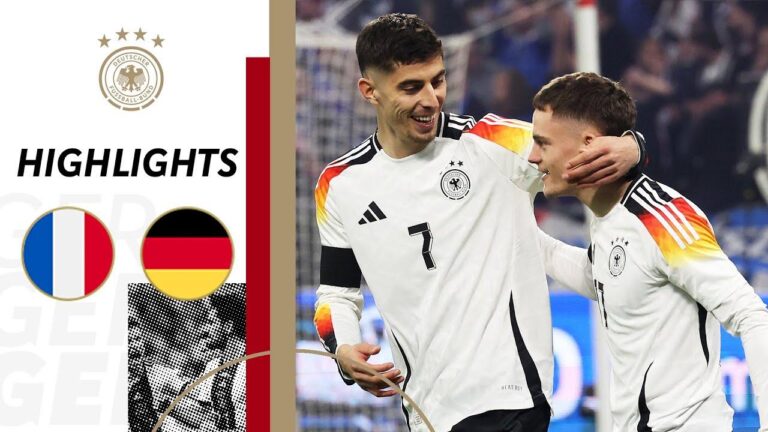In a compelling showdown that captured the attention of football fans worldwide, France secured a 2-0 victory over Germany, underscoring several critical insights into both teams’ strategies and performances. The match, marked by tactical discipline and individual brilliance, not only reinforced France‚Äôs standing on the international stage but also highlighted areas where Germany must improve. Here, we explore three key takeaways from this high-stakes encounter, shedding light on what the result means for the future of both national teams.
Germany’s Defensive Vulnerabilities Exposed in Critical Match
Germany’s usually sturdy defense appeared surprisingly brittle against France’s rapid and incisive attacking play. Despite a well-organized back line, the team struggled to contain the inventive moves of Kylian Mbappé and Antoine Griezmann, who exploited gaps left by hesitant center-backs. Tactical misalignments and a lack of cohesion in the defensive midfield allowed the French to penetrate with ease, leaving goalkeeper Manuel Neuer exposed on multiple occasions.
Key defensive shortcomings included:
- Delayed reactions to quick counterattacks, leading to multiple dangerous situations.
- Poor communication between defenders, resulting in misjudged offsides and open spaces.
- Inadequate support from full-backs, enabling France’s wingers to deliver quality crosses and cutbacks.
| Defensive Aspect | Germany | France |
|---|---|---|
| Successful Tackles | 7 | 13 |
| Interceptions | 8 | 15 |
| Clearances | 10 | 6 |
| Blocked Shots | 3 | 5 |
France’s Tactical Mastery Secures Key Victory
France demonstrated exceptional strategic discipline against Germany, executing a game plan that perfectly balanced defensive solidity with rapid offensive transitions. Their compact midfield effectively stifled Germany’s creative outlets, forcing turnovers that were swiftly converted into scoring opportunities. Key players showed remarkable distance management and positional awareness, allowing France to control the tempo and momentum of the match throughout.
The result was underpinned by a combination of tactical innovations from the coaching staff and precise individual performances. Notably, France’s ability to exploit wide areas and overload opposing defenders created vital space for their forwards to operate in dangerous zones. This adaptive approach allowed the team to maintain pressure without overcommitting, a crucial factor in securing all three points.
- Disciplined midfield control limited Germany’s playmaking.
- Rapid counterattacks exploited defensive gaps effectively.
- Positional fluidity created spaces for key chances.
| Aspect | France | Germany |
|---|---|---|
| Possession (%) | 48 | 52 |
| Shots on Target | 7 | 3 |
| Pass Accuracy (%) | 86 | 81 |
Opportunities for Germany to Rebuild and Improve
Germany’s recent performance highlights critical areas ripe for enhancement as the team looks to rebound. Defensive cohesion, particularly in transition phases, requires urgent attention. The backline struggled with positioning, opening spaces that France exploited with precision. Furthermore, the midfield showed signs of disjointed play, lacking the creativity and control necessary to dictate the game’s tempo against a high-caliber opponent.
To regain competitive edge, Germany must focus on:
- Strengthening defensive communication and spatial awareness
- Enhancing midfield coordination to improve ball retention and distribution
- Integrating emerging talents to inject dynamism and unpredictability
| Focus Area | Challenge | Potential Solution |
|---|---|---|
| Defense | Loose marking and spacing | Intensified tactical drills and video analysis |
| Midfield | Low ball recovery rate | Improved pressing strategy and fitness training |
| Offense | Predictable attacking patterns | Develop varied attack plans and fluid formations |
Strategic Lessons for Future International Fixtures
Adaptability Under Pressure: France’s ability to switch tactical setups mid-game was a masterclass in flexibility, leaving Germany‚Äôs defense disoriented. Future fixtures will demand national teams to train for dynamic game plans that can seamlessly evolve as the match unfolds. This includes having versatile players capable of filling multiple roles, ensuring the team can sustain momentum regardless of opposition adjustments.
Exploiting Transitional Phases: The match highlighted how quickly France capitalized on Germany’s transitional vulnerabilities, turning moments of change into scoring opportunities. Coaches should prioritize drills that sharpen counter-attack execution and defensive transition, focusing on speed and precision. To illustrate this, here’s a breakdown of key transition moments from the game:
| Moment | Outcome | Player Involved |
|---|---|---|
| Turnover in midfield | Quick break to penalty box | Kanté |
| Defensive clearance | Long pass to winger | Varane |
| Opponent pressing high | Space exploited on flank | Mbappé |
- Prepare for fluid tactical shifts through scenario-based training.
- Enhance players’ decision-making speed in transitional moments.
- Develop strong communication to maintain structure amid pressure.
Closing Remarks
In summary, Germany’s 0-2 defeat to France offered valuable insights into both teams’ current dynamics, tactical approaches, and player performances. The match highlighted France’s clinical finishing and defensive discipline, while exposing areas where Germany must improve to regain their competitive edge. As both sides look ahead to upcoming fixtures, these lessons will undoubtedly shape their strategies moving forward.




